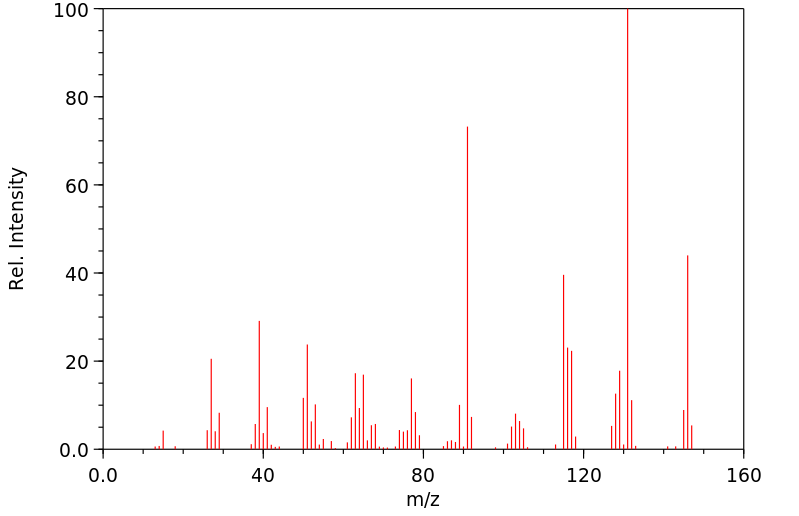(E)-2-methyl-1-phenyl-1-butene | 7302-03-6
中文名称
——
中文别名
——
英文名称
(E)-2-methyl-1-phenyl-1-butene
英文别名
(2-methylbut-1-en-1-yl)benzene;2-methyl-trans-1-phenyl-1-butene;Benzene, (2-methyl-1-butenyl)-;[(E)-2-methylbut-1-enyl]benzene
CAS
7302-03-6
化学式
C11H14
mdl
——
分子量
146.232
InChiKey
OQYUFQVPURDFKC-MDZDMXLPSA-N
BEILSTEIN
——
EINECS
——
-
物化性质
-
计算性质
-
ADMET
-
安全信息
-
SDS
-
制备方法与用途
-
上下游信息
-
文献信息
-
表征谱图
-
同类化合物
-
相关功能分类
-
相关结构分类
物化性质
-
沸点:198-200 °C
-
密度:0.895±0.06 g/cm3(Predicted)
计算性质
-
辛醇/水分配系数(LogP):4
-
重原子数:11
-
可旋转键数:2
-
环数:1.0
-
sp3杂化的碳原子比例:0.27
-
拓扑面积:0
-
氢给体数:0
-
氢受体数:0
SDS
上下游信息
-
上游原料
中文名称 英文名称 CAS号 化学式 分子量 —— (2-methyl-but-1-enyl)-benzene 13384-54-8 C11H14 146.232 环亚丙基甲基苯 1-phenylmethylenecyclopropane 7555-67-1 C10H10 130.189 —— 1-phenylbut-1-ene 824-90-8 C10H12 132.205 (2-甲基丁-1,3-二烯基)苯 (E)-2-methyl-1-phenyl-1,3-butadiene 37580-42-0 C11H12 144.216 -
下游产品
中文名称 英文名称 CAS号 化学式 分子量 —— (2-methyl-but-1-enyl)-benzene 13384-54-8 C11H14 146.232
反应信息
-
作为反应物:参考文献:名称:Roth, Wolfgang R.; Staemmler, Volker; Neumann, Martin, Liebigs Annalen, 1995, # 6, p. 1061 - 1118摘要:DOI:
-
作为产物:描述:参考文献:名称:The Migration Aptitude of Benzyl vs. Methyl in Carbonium Ion Reactions of the 2,2-Dimethyl-3-phenyl-1-propyl System摘要:DOI:10.1021/ja00880a026
文献信息
-
Preparation and reactions of monocyclic bis(cyclopentadienyl)titanacyclopentenes and -pentadienes作者:Kimihiko Sato、Yasushi Nishihara、Shouquan Huo、Zhenfeng Xi、Tamotsu TakahashiDOI:10.1016/s0022-328x(01)01072-5日期:2001.8be very effective for the formation of monocyclic titanacyclopentenes in excellent yields. On the other hand, a combination of Cp2TiCl2–2n-BuLi was used for intermolecular coupling of two alkynes to form titanacyclopentadienes in good to excellent yields. A reaction temperature range from −10 to −30 °C was critical for the success of the combinations. Reactions of these in situ-prepared titanacycles
-
Silica-Supported Dendrimer-Palladium Complex-Catalyzed Selective Hydrogenation of Dienes to Monoolefins作者:Pumza P. Zweni、Howard AlperDOI:10.1002/adsc.200505236日期:2006.4The selective hydrogenation of cyclic and acyclic dienes to monoolefins occurs under very mild conditions, in the presence of silica-supported PAMAM-Pd complexes. The activity and selectivity of this reaction is sensitive to the dendrimer structure. These dendritic complexes display excellent recycle properties, retaining activity for up to eight recycles.在二氧化硅负载的PAMAM-Pd络合物的存在下,在非常温和的条件下,环状和非环状二烯选择性氢化为单烯烃。该反应的活性和选择性对树枝状大分子结构敏感。这些树状复合物显示出优异的循环特性,最多可保留八次循环的活性。
-
Polylithiumorganic Compounds - 19.作者:Adalbert Maercker、Volker E.E. DaubDOI:10.1016/s0040-4020(01)86961-1日期:1994.2α-methylbenzylidenecyclopropane (32c) this rearrangement was shown to occur intermolecularly via a trilithiumorganic compound 56. The suggested mechanism of these reductive metalation reactions via a bisected radical anion 87 where the lithium is mainly bound to the cyclopropyl carbon atom and oriented syn to the phenyl ring, was supported by MNDO (geometries) and ab initio (energies) calculations.
-
Formation of cyclopropanes in γ-eliminations of sulphoxides作者:R. Baker、M. J. SpillettDOI:10.1039/j29690000581日期:——formed in dimethyl sulphoxide than in triethylamine. The increasing proportions of 1,3-elimination are discussed in terms of an entropy effect, and the decreasing amounts of 1,2-elimination is in terms of the steric interactions in the transition state for a concerted elimination. That the 1,3-elimination is favoured in dimethyl sulphoxide is explained in terms of the different natures of the two solvents一些2-烷基-1-甲基亚磺酰基-3-苯丙烷类(烷基= H,Me中,乙基,丙基我,或卜吨)已经制备; 在酰胺钾-三乙胺和甲基亚磺酰基甲基甲烷-二甲亚砜钠的体系中研究了它们的分解。通过最初形成的2-烷基-3-苯基丙烯的异构化,仅通过反式-1-烷基-2-苯基环丙烷的1,3-消除和通过反式1- β-烷基-β-甲基苯乙烯的1,2-消除主要产生反式-β-烷基-β-甲基苯乙烯。取代的环丙烷的相对量通过H系列增加<我<的Et <镨我<卜吨,并且对于每种底物,在二甲基亚砜中比在三乙胺中形成更多的环丙烷。1,3-消除的比例增加是通过熵效应来讨论的,1,2-消除的减少量是以过渡态下的空间相互作用来协调消除的。从两种溶剂的不同性质及其对E 1 cB 1,3-消除和协同1,2-消除的影响方面解释了在二甲亚砜中偏爱1,3-消除的方法。制备了2,2-二甲基-1-甲基亚磺酰基-3-苯基丙烷,1-甲基亚磺酰基-2,3-二苯
-
Pair-Selective Coupling of Alkynes with Alkenes on Zirconocene Complex作者:Tamotsu Takahashi、Zhenfeng Xi、Christophe J. Rousset、Noriyuki SuzukiDOI:10.1246/cl.1993.1001日期:1993.6When ethylene and alkynes such as 4-octyne and diphenylacetylene were treated with Cp2ZrBu2 highly pair selective coupling products were formed in high yields. Similarly, styrene or trimethylvinylsilane also afforded cross coupling products with alkynes on zirconocene complex.
表征谱图
-
氢谱1HNMR
-
质谱MS
-
碳谱13CNMR
-
红外IR
-
拉曼Raman
-
峰位数据
-
峰位匹配
-
表征信息
同类化合物
(βS)-β-氨基-4-(4-羟基苯氧基)-3,5-二碘苯甲丙醇
(S,S)-邻甲苯基-DIPAMP
(S)-(-)-7'-〔4(S)-(苄基)恶唑-2-基]-7-二(3,5-二-叔丁基苯基)膦基-2,2',3,3'-四氢-1,1-螺二氢茚
(S)-盐酸沙丁胺醇
(S)-3-(叔丁基)-4-(2,6-二甲氧基苯基)-2,3-二氢苯并[d][1,3]氧磷杂环戊二烯
(S)-2,2'-双[双(3,5-三氟甲基苯基)膦基]-4,4',6,6'-四甲氧基联苯
(S)-1-[3,5-双(三氟甲基)苯基]-3-[1-(二甲基氨基)-3-甲基丁烷-2-基]硫脲
(R)富马酸托特罗定
(R)-(-)-盐酸尼古地平
(R)-(-)-4,12-双(二苯基膦基)[2.2]对环芳烷(1,5环辛二烯)铑(I)四氟硼酸盐
(R)-(+)-7-双(3,5-二叔丁基苯基)膦基7''-[((6-甲基吡啶-2-基甲基)氨基]-2,2'',3,3''-四氢-1,1''-螺双茚满
(R)-(+)-7-双(3,5-二叔丁基苯基)膦基7''-[(4-叔丁基吡啶-2-基甲基)氨基]-2,2'',3,3''-四氢-1,1''-螺双茚满
(R)-(+)-7-双(3,5-二叔丁基苯基)膦基7''-[(3-甲基吡啶-2-基甲基)氨基]-2,2'',3,3''-四氢-1,1''-螺双茚满
(R)-(+)-4,7-双(3,5-二-叔丁基苯基)膦基-7“-[(吡啶-2-基甲基)氨基]-2,2”,3,3'-四氢1,1'-螺二茚满
(R)-3-(叔丁基)-4-(2,6-二苯氧基苯基)-2,3-二氢苯并[d][1,3]氧杂磷杂环戊烯
(R)-2-[((二苯基膦基)甲基]吡咯烷
(R)-1-[3,5-双(三氟甲基)苯基]-3-[1-(二甲基氨基)-3-甲基丁烷-2-基]硫脲
(N-(4-甲氧基苯基)-N-甲基-3-(1-哌啶基)丙-2-烯酰胺)
(5-溴-2-羟基苯基)-4-氯苯甲酮
(5-溴-2-氯苯基)(4-羟基苯基)甲酮
(5-氧代-3-苯基-2,5-二氢-1,2,3,4-oxatriazol-3-鎓)
(4S,5R)-4-甲基-5-苯基-1,2,3-氧代噻唑烷-2,2-二氧化物-3-羧酸叔丁酯
(4S,4''S)-2,2''-亚环戊基双[4,5-二氢-4-(苯甲基)恶唑]
(4-溴苯基)-[2-氟-4-[6-[甲基(丙-2-烯基)氨基]己氧基]苯基]甲酮
(4-丁氧基苯甲基)三苯基溴化磷
(3aR,8aR)-(-)-4,4,8,8-四(3,5-二甲基苯基)四氢-2,2-二甲基-6-苯基-1,3-二氧戊环[4,5-e]二恶唑磷
(3aR,6aS)-5-氧代六氢环戊基[c]吡咯-2(1H)-羧酸酯
(2Z)-3-[[(4-氯苯基)氨基]-2-氰基丙烯酸乙酯
(2S,3S,5S)-5-(叔丁氧基甲酰氨基)-2-(N-5-噻唑基-甲氧羰基)氨基-1,6-二苯基-3-羟基己烷
(2S,2''S,3S,3''S)-3,3''-二叔丁基-4,4''-双(2,6-二甲氧基苯基)-2,2'',3,3''-四氢-2,2''-联苯并[d][1,3]氧杂磷杂戊环
(2S)-(-)-2-{[[[[3,5-双(氟代甲基)苯基]氨基]硫代甲基]氨基}-N-(二苯基甲基)-N,3,3-三甲基丁酰胺
(2S)-2-[[[[[((1S,2S)-2-氨基环己基]氨基]硫代甲基]氨基]-N-(二苯甲基)-N,3,3-三甲基丁酰胺
(2S)-2-[[[[[[((1R,2R)-2-氨基环己基]氨基]硫代甲基]氨基]-N-(二苯甲基)-N,3,3-三甲基丁酰胺
(2-硝基苯基)磷酸三酰胺
(2,6-二氯苯基)乙酰氯
(2,3-二甲氧基-5-甲基苯基)硼酸
(1S,2S,3S,5S)-5-叠氮基-3-(苯基甲氧基)-2-[(苯基甲氧基)甲基]环戊醇
(1S,2S,3R,5R)-2-(苄氧基)甲基-6-氧杂双环[3.1.0]己-3-醇
(1-(4-氟苯基)环丙基)甲胺盐酸盐
(1-(3-溴苯基)环丁基)甲胺盐酸盐
(1-(2-氯苯基)环丁基)甲胺盐酸盐
(1-(2-氟苯基)环丙基)甲胺盐酸盐
(1-(2,6-二氟苯基)环丙基)甲胺盐酸盐
(-)-去甲基西布曲明
龙蒿油
龙胆酸钠
龙胆酸叔丁酯
龙胆酸
龙胆紫-d6
龙胆紫








